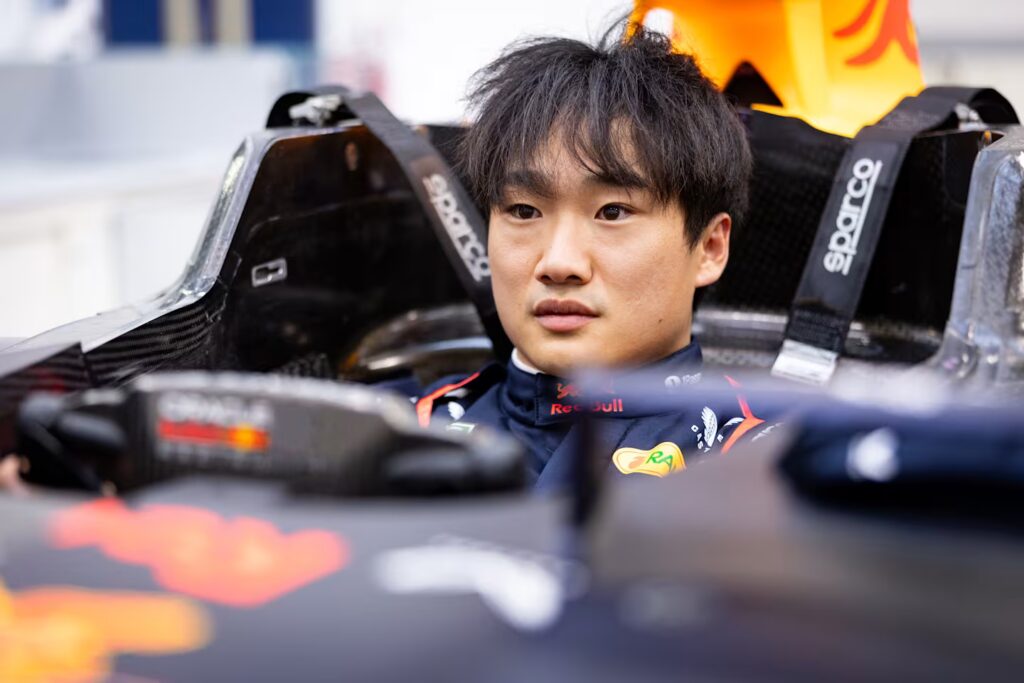
After years of being passed over, Yuki Tsunoda finally earns his place in the Red Bull spotlight—amid leadership misfires, driver swaps, and a long trail of deflections.
The Shot That Almost Never Came
Yuki Tsunoda is officially a Red Bull Racing driver. It’s the kind of statement that once felt like it would never happen—not because of talent, but because of timing, politics, and a seemingly endless list of teammates and near-misses. But now, after years of patience, grit, and steady progress, Tsunoda finally has the seat. And with the Tokyo showcase event done and dusted, it captured more than just a branding exercise. It signaled the end of the waiting era—and the start of something real.
From Firecracker to Foundation
Tsunoda’s journey hasn’t been linear. He was once the emotional rookie with an explosive radio presence. But across the last two seasons, he’s steadily evolved—maturing as a driver and as a voice within his team. During the Tokyo event, he spoke in Japanese to a home crowd, asking them to please pressure him, expect more from him, because that’s how he’ll grow. He wasn’t asking to be protected—he was asking to be pushed.
It was a classically Japanese sentiment—one that resonated with older fans and newer ones alike. Humble, determined, and quietly brave.
The Excuse Machine Keeps Running
Red Bull, naturally, hasn’t handled the transition so gracefully. After picking Liam Lawson over Yuki last season, Helmut Marko recently claimed it wasn’t his fault. According to him, it was Adrian Newey who blocked the promotion—because of a 2022 incident at Silverstone where Yuki collided with Gasly and debris allegedly damaged Verstappen’s floor.
The backlash was swift. Fans rightly questioned why a former employee’s personal grudge was dictating 2024 driver decisions. Newey had already been sidelined and on gardening leave by the time that call was made. The excuse felt both petty and desperate—classic Red Bull spin, shifting responsibility when things don’t pan out.
The Engineers Spoke
What’s more credible is the report that Red Bull’s engineers pushed for the switch after Lawson’s two-race stint in the RB21. His feedback was reportedly vague, unhelpful, and unproductive—leaving engineers scrambling. Meanwhile, Yuki had impressed during post-season testing, offering clear, actionable insights. In a car that’s proven tricky to set up and even trickier to extract pace from, technical feedback became the currency—and Tsunoda had more of it.
Lawson Deserved Better
That doesn’t mean Lawson deserved the fallout. He was thrown into the most difficult seat in the sport with minimal preparation, under maximum pressure. He didn’t lash out. He didn’t blame the car. And yet, he became the scapegoat for a decision the leadership now claims they never really made.
Fans have debated his attitude, questioned his comments about beating Yuki in junior formulas, and fixated on moments like the Checo finger gesture. But even his harshest critics agree: Red Bull did him no favors. He was used as a patch, not given a path.
A Seat Redefined
Now it’s Yuki’s turn. And he’s not here to dethrone Verstappen—he’s here to finally stabilize the second seat. Red Bull doesn’t need another phenom. They need someone who can qualify solidly, deliver in the races, and help develop the car. Yuki fits that bill. He’s consistent, confident, and no longer seen as a liability.
He’s not here by accident. He’s here because there was no more logical choice.
The Weight of Legacy
As the build-up to Suzuka intensified, the FIA stoked the moment with a post highlighting the best-ever results by Japanese drivers in Formula 1. Kamui Kobayashi’s emotional podium in Japan. Aguri Suzuki’s historic P3 at Suzuka in 1990. Takuma Sato’s near-misses. For longtime fans, it brought back a flood of memories.
One fan recalled staying up past 1:30 a.m. in 2012 to watch Kobayashi cross the line, screaming “Kamui! Kamui! Kamui!” alone in their living room. For others, it was the memory of Yuki’s P4 in Abu Dhabi 2021—overshadowed by title drama, but remembered for an audacious move on Bottas in the final lap.
Now, there’s a quiet, hopeful pressure. Could this be the year a Japanese driver finally steps back on the podium—at home?
Some fans have gone full hopium: “They’re going to have to update that graphic Monday with Yuki P1.” Others joked they’re betting their house on it. And while skepticism remains, so does belief. Even a top-five finish would be a moment. A podium? That would be history.
Hopium, with Roots
What’s happening with Yuki isn’t blind hope. It’s not a fairytale. It’s a story built on endurance—of surviving the Red Bull system, of improving in public, of refusing to be forgotten.
He’s not here to make headlines. He’s here to rewrite them.
Whatever happens at Suzuka, whatever the result, this much is certain:
Yuki Tsunoda has already changed what it means to be a Japanese driver in Formula 1.
Now he has the car.
Now he has the chance.
And this time, it’s his to take.
